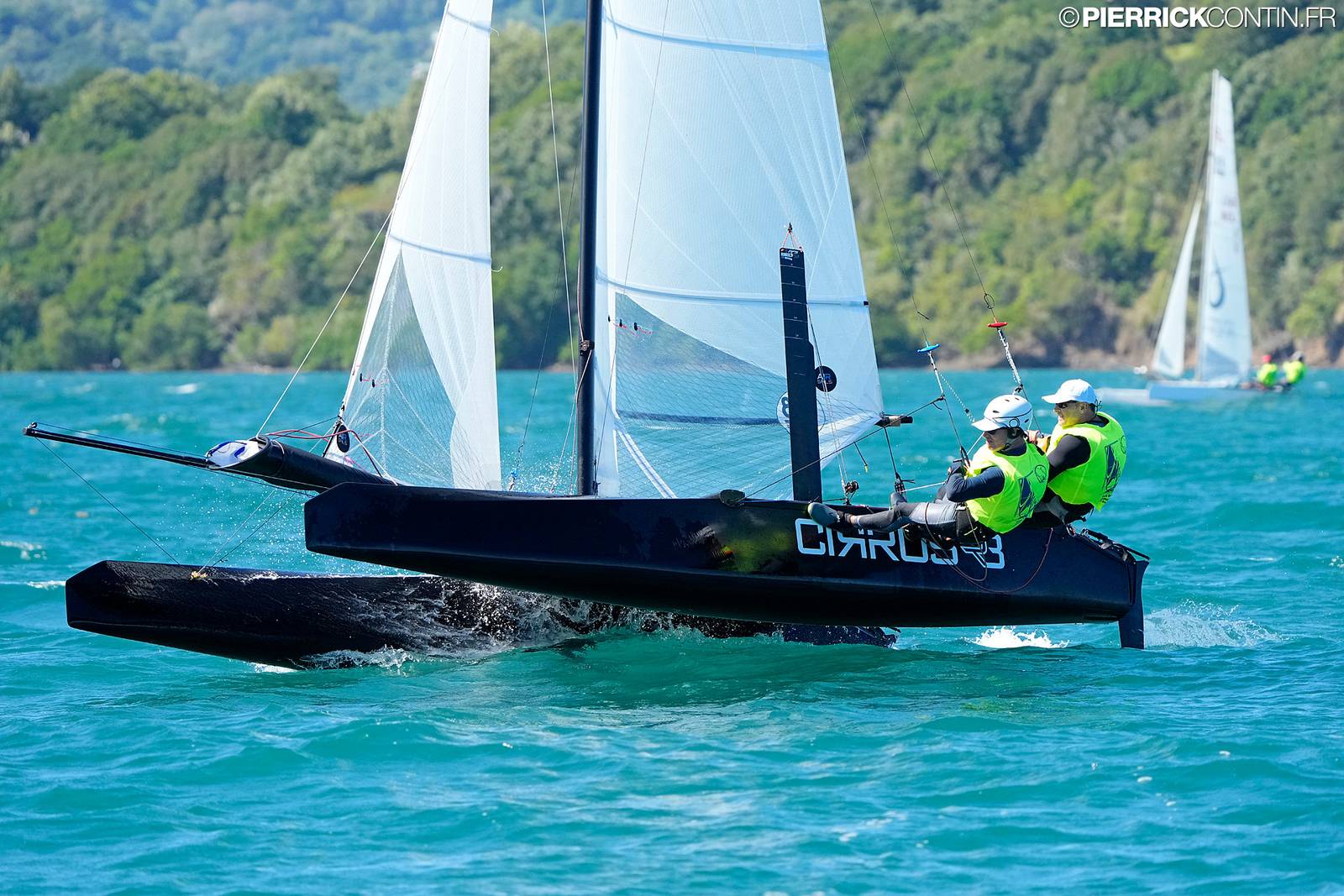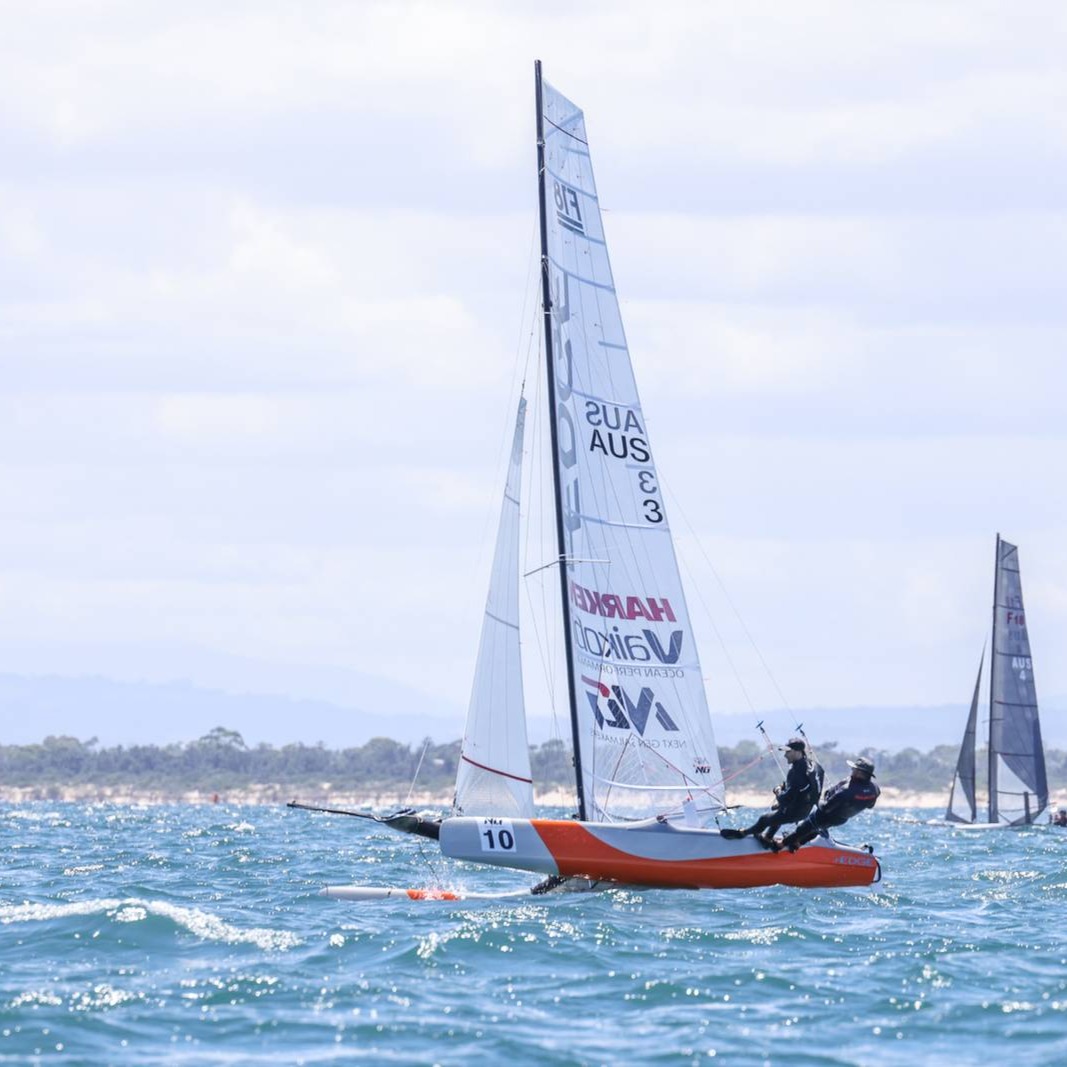Formula 20 Revival proposal, by David White
Photo: Laurens Morel / Nacra Sailing.
Formula 20 Revival
by David White
[email protected]
Introduction
I am working to build interest in the F20 Class Organization in North America.
F20 does not seem to be an active class, however, the F18 class is strong and active. Is there
interest in reinvigorating an F20 Class? This article is intended to “shake the proverbial trees”
and see what falls out.
The ideal competitive crew weight for F18 is 150 kg (330lb)1 for 2 people. I am interested in
sailing in the F18 class, but my overall skipper and crew weight do not allow me to be as
competitive as I would like. I have not been able to find a skilled and reliable 70lb crew member
or skipper. I have been fortunate enough to sail with family, however, our crew weight ranges
from 400-500 lb. (geared up) depending on who is sailing. The 20 ft boat class is very forgiving
to this larger crew weight range, which is beneficial to others with skipper and crew that are
above average.
These days we are sailing in an Open class against a modified Nacra C20 because there are
currently so few 20 foot cats to compete against. The F18 sailors have graciously allowed us to
race with them in some local F18 events. However, there are mixed feelings about allowing a
20ft cat in an F18 class race.
Over the years there have been many active fleets of 20 foot cats such as Hobie 20 Miracles,
Nacra 6.0, I20, Mystere 6.0, Tornados, and Supercats. I think back fondly to open Hobie
regattas in the 2000’s in New England that had 14 Nacra 6.0s and several I20s on a race
course. Many of the 6 meter sailors transitioned to the I20. Most of this generation of sailors
are no longer active, having sold their boats to others. Where did these boats go? Some boats
have been scrapped, but not all of them. There are hundreds of boats around. I would love for
these boats to return to active sailing.
Proposal
Regatta attendance has been dwindling for many years. Many of us enjoy larger regattas and
fun-sails with many participants. My goal is to increase attendance at events, wherever they
may be. This will hopefully lead to having more events with many sailors.
I propose building an F20 class. If we organize an inclusive class for 20 ft boat owners, this
new class would then be eligible to register for existing regattas. Many yacht clubs and race
organizers are open to adding classes to a regatta providing there are at least 4 boats to justify
the class such as the F20. I have found race organizers are typically open to recording times
for handicap purposes when different model boats compete in the same class.
NEMA (New England Multihull Association) allows membership to multihulls that fit an F20
class. Several of the NEMA events are raced by F20 cats each summer. NEMA calculates
ratings to individual boat owners along with boat specific details. The rating evolves based on
actual sailing performance of a specific boat and skipper combination over time. This is helpful
assuming a Hobie 20 would be racing with a Tornado, Supercat, or Nacra Carbon 20. The class
would start with estimated individual ratings that improve over time. I do not believe an
exclusive and restrictive one-design F20 class will be possible, and encourage a more inclusive
approach.
An inclusive F20 class can also help coordinate fun-sail and picnic events to promote
recreational sailing, as not everyone is always into racing all the time. Recreational sailing is key
to getting more people interested in performance cat sailing. An F20 can fit 2-4 crew members
while performing spiritedly.
Please reach out to me if you are interested in helping coordinate F20 membership and class
charter to bring a group of sailors together.
I have included a brief background of F20 and comparison of production 20 foot beach cats
below (based on my experience).
Background
The Formula 20 catamaran class was originally started as the B-class in the 1960s by IYRU
(current ISAF). Classes A-D were development classes with minimal box rules.
The B-class rules started with a maximum length of 20’, maximum beam of 10’, a total
maximum sail area of 235 square feet and a crew of 2.
In 1967, the Tornado was created to fit within these specifications and became the Olympic
catamaran for many years. This was the oldest and most popular F20 type boat.
The B-class evolved into an International F20 class defined as: 2
Minimum rigged boat weight: 150kg / 330 lb
Maximum boat length (LOA): 6.2m /20.33ft (excluding rudders and spinnaker pole)
Maximum width (Beam): 3.5m / 11.48ft (including wings and foils)
Maximum upwind sail area including mast: 25m2 / 268.8 ft2
Maximum downwind sail area including mast: 55m2 / 591.3 ft2
Maximum sail area of mast: 3m2 / 32.25 ft2
Manufacturers have taken many liberties calling various boats F20 over the years with a fair
amount of variation. The Hobie 20 was not initially sailed with a spinnaker, yet many different
spinnakers have subsequently been added to Hobie 20 by their owners with successful results.
The iF20 was a European Nacra Inter 20 with a reduced sail area. Legend goes the smaller sail
area would strategically make the iF20 more competitive to match the F18 class.
The F18 ended up being a faster class, and therefore the iF20 did not continue over time. Nacra
subsequently swung the pendulum in the other direction, creating the F20 Carbon.
The F20 Carbon has a larger upwind sail area than the historical F20 definition. The F20 Carbon has
gone through significant upgrades from straight boards, to curved boards, to foils and flight
control systems and recently an evolution to a deck sweeper.
Within F20 Carbon boat alone there are 4-5 significant performance variations that would typically result in different ratings.
Because of the diversity and ever changing manufacturing models, I do not believe we can
achieve a one design exclusive class. Therefore, I propose creating an inclusive F20 class that
is based off of IYRU F20 specifications and ratings based on the NEMA philosophy.
Refer to Table 1 for a partial comparison of F20 boats.
| IYRU F20 Rule | NACRA 20 FCS | Inter 20 (Nacra) | Nacra 6.0 | Tornado | Mystere 6.0 | Hobie 20 | Supercat 20 | Marstrom M20 | |
| Length | 20.33 Max | 20.3 | 20 | 19.7 | 20 | 19.7 | 19.7 | 19 | 20 |
| Beam | 11.48 Max | 10.5 | 8.5 | 8.5 | 10.1 | 8.3 | 8.5 | 12 | 10 |
| Main | 226 | 194 | 179 | 195 | 237 | ||||
| Jib | 56 | 52 | 57 | 55 | |||||
| Spinnaker | 322.5 Max | 301 | 269 | 269 | 226 | 237 | |||
| Main & Jib Area | 268.8 Max | 282 | 246 | 264 | 236 | 250 | 275 | ||
| Total Sail | 591.3 Max | 583 | 515 | 505 | 474 | ||||
| Displacement | 330 Min | 375 | 419 | 420 | 400 | 450 | 254 |





























I just heard that my great sailing friend and former CEO of Hobiecat Europe has passed. May The endless oceans…
...Report was sent by an F18 Sailor, if you want Hobies reported send your own, we'll publish as usual. Cheers.
Looks like in your report the Hobies are not really present. Suggest to rewrite the article.
Thanks for the great report Wik. Great battle.
If I correctly read the results the overall winner this year is a Hobie16